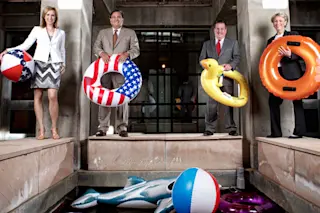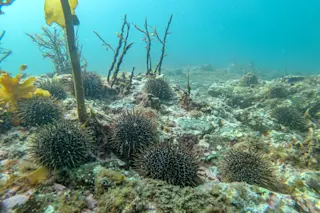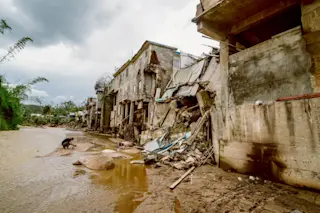Climate change and population growth are both stressing the planet’s freshwater supply. Our experts debate the tough choices scientists, politicians, and the general public will have to make to adapt to a world where water could outstrip fuel as the most prized commodity.
This year, Texas suffered through the worst one-year drought in its history, while states along the Mississippi River endured record flooding. Shifting climate patterns mean these radical disruptions could be a harbinger of things to come.
DISCOVER recently partnered with NBC Learn, the National Science Foundation, and Arizona State University to convene a town hall discussion that explored the impact of climate change on our freshwater resources. Anne Thompson, NBC’s chief environmental affairs correspondent, moderated the expert panel, which included (from left): Heidi Cullen, a correspondent for Climate Central, a nonprofit that reports on climate science; Bill Richardson, former governor of New Mexico and a board member of the World Resources Institute, an environmental think tank; Grady Gammage Jr., a practicing attorney and a senior scholar at the ASU Global Institute of Sustainability; and Pat Mulroy, general manager of the Southern Nevada Water Authority.
Anne Thompson: Water covers more than 70 percent of the Earth, but only 2.5 percent of it is freshwater. And two-thirds of that is locked up in ice caps and glaciers. Freshwater accessible in lakes, rivers, and streams is just six-thousandths of one percent of the world’s total water. With that in mind, what is the status of freshwater around the world today?
Heidi Cullen: Freshwater around the world is definitely stressed, and climate change is the great exacerbation. With water, the rich get richer globally, and the poor get poorer. Places that tend toward drought are going to see it more. The subtropical drought regions will expand. And in places like Asia, the monsoon system is expected to intensify. It’s a problem of greater uncertainty, greater variability, and more stress overall.
Thompson: Governor Richardson, do you see water scarcity as a source of global crisis?
Governor Bill Richardson: It is a huge international issue about to explode, and in some areas it’s already a crisis. Look at Somalia, where there is a famine caused by a drought and then militants preventing people from getting water and food. In a country like Bangladesh, where most people live in coastal areas, the opposite is true—there’s too much water, and sometime in this century some of those coastal cities will disappear.
Thompson: Heidi, what areas are at greatest risk for climate change affecting freshwater resources?
Cullen: When we look out to the middle of the century, the models show that the Mediterranean and the Middle East are going to see trouble. Here in the American Southwest, the models seem to agree that we are creeping up on a drier and drier climate.
Thompson: Governor Richardson, do you agree with the idea that the wars of the 21st century will be fought over water?
Richardson: Yeah, I think they will be. We’re facing a growing water crisis in the Middle East, especially in Jordan and in some of the Arab areas adjoining Israel. If we’re talking about human beings dying because of water resources, because of famine, it’s Africa.
Thompson: Is climate change the main reason we are having trouble with freshwater in this world?
Cullen: It’s part of an entire orchestra of different issues playing out. Population growth is definitely a really big player. And keep in mind that climate has always changed. In the Southwest, paleoclimate records tell us that we have seen tremendous droughts—megadroughts—in the past. When you put climate change on top of that, it just stresses everything more.
Thompson: Here in Phoenix, one of every three homes has a pool, and up to 70 percent of the water is used outside. Water here is cheap. You’re all saying we have to think about water differently and make some difficult choices. Grady, what are those choices?
Grady Gammage Jr.: It’s not that there’s going to be a day when you turn on the tap and water doesn’t come out. We have too robust a water system and too good a political system. But we’re going to have to decide how important it is to keep growing, which is how we define success. Should everybody have a private swimming pool? Or should we do the kind of things that Pat [Mulroy] did in Las Vegas when she got people to rip out the grass from their lawns?
Thompson: Water is an issue that requires us to work together. We’re in Arizona, which is one of the seven states that share the Colorado River and play by the rules set out in the 1922 Colorado Compact. Pat Mulroy, you’re responsible for getting water to some 2 million Las Vegas residents, and 90 percent of that comes out of the Colorado River via Lake Mead. Can you explain how this kind of consensus works?
Mulroy: At the end of the day, the Colorado Compact is an agreement that allows seven states to do whatever seven states can agree to do, but no one state can rule its neighbors no matter how big it is. That’s the beauty of the compact. As it stands now, we move the Colorado River across the Continental Divide through the Rocky Mountains to Colorado’s front range to the Kansas-Nebraska watershed. In New Mexico, we move that water to Albuquerque into the Rio Grande watershed. In Utah, we move it across the Utah desert to the Wasatch Front. Here in the middle of Arizona, we’re moving Colorado River water along a massive aqueduct. California moves the water 400 miles through an aqueduct to the coastal cities. It goes on and on and on. We’re all interconnected.
Gammage: Water is the ultimate tribal commodity. Water defines our tribe—those with whom we share water are us. Those who are trying to take it away are them. And the big them in the Southwest is California. We needed to be allies to deal with California. And Arizona and Nevada have been pretty good allies.
Mulroy: You can’t push at one end of this system and not feel the effects in another part of the system.
Cullen: If I can just put the climate lens on top of that, we made some really key decisions in the 1900s when we decided what the normal water flow was for the Colorado River, and normal was 17 million acre-feet in a year. During the drought from 2001 to 2006, it was actually 11 million acre-feet. And in 2002 it was as low as 6 million acre-feet. So what was normal in the 1900s is not normal now.
Thompson: Pat, what kind of stress is population growth putting on your freshwater resources?
Mulroy: Ten years ago I would have said that population growth is putting a tremendous stress on it. But in Las Vegas we had so much pressure when the drought hit that we became extremely aggressive about conservation. We reduced the amount of water southern Nevada was using by one-third since then, despite the fact that we increased our population by 400,000.
Gammage: The remarkable thing about Las Vegas is how quickly they were able—led by Pat—to make this change. Arizona has been decreasing its water use slowly for a longer period of time. The city of Phoenix today uses about the same amount of water as a decade ago because of per capita reductions. We took water away from farming in times of drought, and we urbanized land and water at the same time. It’s been a fairly orderly transition without doing some of the draconian things that Pat did in Las Vegas.
Thompson: What about building big water infrastructure as a way to solve water problems?
Gammage: I have this sense that we have lost our collective will to build things: pipelines, the Central Arizona Project canal, Hoover Dam, those kinds of things.
Thompson: Pat, the state engineer is supposed to rule by the end of next January on one of your big initiatives, your request to bring 65 billion gallons of water from northern Nevada to Las Vegas. Do you see this issue as a rural versus city fight?
Mulroy: No, I don’t. We filed for unappropriated, unused water. If Lake Mead, which has been in a drought for nearly a decade, hits elevations of 1,075 feet or, God forbid, 1,025 feet, where is southern Nevada’s water going to come from? It is impossible to conserve 90 percent of your water supply. There has to be a pressure release valve, and that’s what we’re asking for.
Cullen: I want to add that the Colorado Compact was established in 1922, a relatively wet period. The Colorado Compact was a really long-term decision made on a short record. Now, in the Midwest, we’re feeling that all these flooding events we’re seeing are the new normal and will continue to happen. The climate is shifting and we have to adapt.
Audience member: We know that the 20th century was the era of big dams, big infrastructure projects. Considering climate change and population growth, what is the next wave in developing our water resources?
Richardson: You can’t have sensible water policies without taking climate change and renewable energy and what we use into consideration. My state is an oil and gas state, and the oil guys don’t like me too much because what I’ve been saying is that we have to shift from fossil fuels to renewable energy—solar, wind, biomass, et cetera. Renewable energy uses less water. We need a dramatic reduction of man-made greenhouse gas emissions.
Mulroy: You’re going to do everything—increased efficiency, conservation regulations, recycled water, desalination, and more. There’s no silver bullet solution anymore. It’s a mosaic. And it’s going to depend on where you are. Singapore has a water supply that is leaning toward reuse and ocean desalination. They just build one big plant after another.
In this country, and in the world, actually, water use for purposes of energy generation is approaching or surpassing water use for agriculture. It’s power, and there are limits. So the next wave has to be everything, starting with much less demand by our customers.
Gammage: It’s hard to get the public to understand all those things. It’s a harder message than “Let’s build an interstate highway system.”
Richardson: You remember when I ran for president? It was short-lived. Water didn’t help me because I proposed a solution that many, including Pat, didn’t like. But I said that in this country we need federal water leadership, and we don’t have it. Maybe we need a water czar of some kind.
Gammage: I’m not convinced that’s a good idea. In Arizona, we have made multiple water decisions in many places, examining the decisions from multiple perspectives. A water czar might make a big mistake, and I think it would be exceedingly difficult to get the states to agree to that level of federal involvement.
Mulroy: The federal government needs to echo what comes from the state so that the message is the same.
Richardson: When I ran for president I also said, OK, who has water in this country? The Great Lakes states, right? Michigan, Wisconsin. So why don’t we look at some relationship, some compacts, where when we have these water shortages, our brother states can help us.
Mulroy: I’ve actually, believe it or not, embraced this idea in a way. Look at the Mississippi watershed and the massive amount of flooding that’s been occurring there year after year after year. With that resource you can recharge the depleted Ogallala Aquifer under the Great Plains and fuel agricultural areas on the eastern side of the Colorado River Basin, all while protecting the transportation network of the Mississippi, which is the number one use of the Mississippi River. You could floodproof the communities there.
Gammage: There is a perception on many people’s parts that moving water a long distance is a bad thing. It’s not. And water is one of the essential commodities for life that you actually can move. Cities, by definition, draw on a larger area of resources to support themselves. No city has enough rainfall for its whole water supply to be completely sustainable.
Cullen: Unless you’re Chicago.
Mulroy: Yes, unless you sit on Lake Michigan. New York City brings water in from the Catskills. San Francisco brings water in from the Hetch Hetchy reservoir right next to Yosemite, and they move it across the state of California.
Thompson: People in Detroit and Chicago might tell you you’re living somewhere you’re not supposed to—the desert. Why should we give up our water for you guys?
Gammage: I would argue that the desert is a good place to live. It’s a great place to grow crops. It is, perhaps, the birthplace of civilization. The desert is where we first learned to get along and create governments in order to build water systems to make the desert operate. We need to get past territorial approaches to water.
Thompson: We asked our audience what they think the priority of water allocation should be, and they answered, cities and suburbs. I don’t think that’s any big surprise.
Mulroy: Asking that question is the root problem.
Cullen: I agree.
Mulroy: We have to have cities and manufacturing and farming. And there’s the environment. We’ve got to find a fulcrum that respects all four of those needs and can change all the time to adapt to conditions as they emerge.
If food production has to go up by 50 percent in the next 20 years, how are you going do that? Will you shut down the Imperial Irrigation District in southeastern California, which provides 11 percent of the country’s fresh winter fruits and vegetables? There are no easy answers out there.
Audience member: How do we implement farm efficiency measures without limiting our access to highly nutritious and cheap produce?
Gammage: We have made the cost of farming and growing food an incredibly complicated, government-subsidized system. And one of the struggles we have in much of the American West—
Mulroy: You’re a lousy politician [laughs].
Gammage: I’m not running for office. In the West it’s been hard to sell the idea of renewable water supplies to farmers when groundwater, which needs to be pumped, is so heavily subsidized. In Arizona we created programs to make surface water more readily available to farmers. It gets farmers off the groundwater pump, it saves groundwater, and it uses surface water that we keep away from California. There’s a theme here.
Cullen: Keep in mind that for every 1 degree Centigrade (1.8 degrees Fahrenheit) the planet warms up, we see a 10 percent drop in crop yield. The whole notion that the economy should be pitted against the environment is a completely false choice.
Audience member: What role do industry and business have in facilitating a new approach to using water?
Gammage: We’ve got pretty good examples here in Arizona. There are industries that have developed much more efficient ways of watering golf courses, for example—where every single sprinkler head is monitored and controlled by a computer with a sensor in the ground that is related to that sprinkler head. They constantly adjust how much water is delivered to the golf course, and that results in significant water savings. Another company is engaged in water reuse, in dual plumbing systems for subdivisions. Industry is discovering that there are entrepreneurial opportunities in the water arena. Market functions do respond to needs.
Cullen: The thing is, though, that industry needs market signals to respond to. And that requires federal leadership, state leadership, so that those market signals are in place. Policy uncertainty is hindering the innovation that we desperately need. [Applause]
Mulroy: But there’s one other role for industry: a leadership role. One of the most effective ways we got our message out on water conservation was by going directly to industry. The business community isn’t just there to help innovate, though that’s critical. It can complement the message that’s coming from the scientific community and from the elected leadership. Industry can depoliticize it and make water conservation a real issue. They have an enormous voice in that.















